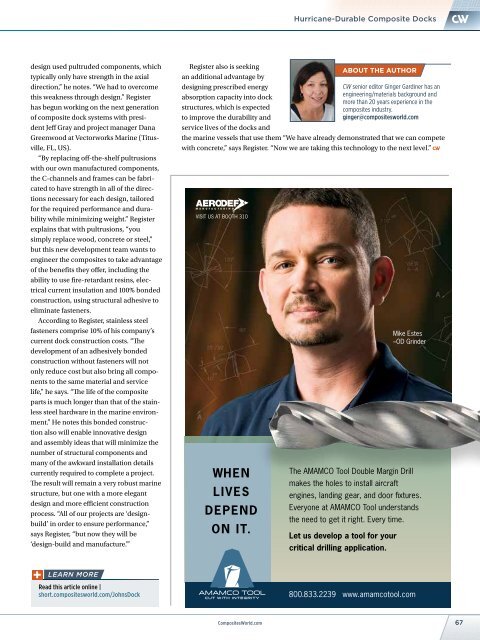FOR AUTO RTM
1VeKpGy
1VeKpGy
You also want an ePaper? Increase the reach of your titles
YUMPU automatically turns print PDFs into web optimized ePapers that Google loves.
Hurricane-Durable Composite NEWS Docks<br />
design used pultruded components, which<br />
typically only have strength in the axial<br />
direction,” he notes. “We had to overcome<br />
this weakness through design.” Register<br />
has begun working on the next generation<br />
of composite dock systems with president<br />
Jeff Gray and project manager Dana<br />
Greenwood at Vectorworks Marine (Titusville,<br />
FL, US).<br />
“By replacing off-the-shelf pultrusions<br />
with our own manufactured components,<br />
the C-channels and frames can be fabricated<br />
to have strength in all of the directions<br />
necessary for each design, tailored<br />
for the required performance and durability<br />
while minimizing weight.” Register<br />
explains that with pultrusions, “you<br />
simply replace wood, concrete or steel,”<br />
but this new development team wants to<br />
engineer the composites to take advantage<br />
of the benefits they offer, including the<br />
ability to use fire-retardant resins, electrical<br />
current insulation and 100% bonded<br />
construction, using structural adhesive to<br />
eliminate fasteners.<br />
According to Register, stainless steel<br />
fasteners comprise 10% of his company’s<br />
current dock construction costs. “The<br />
development of an adhesively bonded<br />
construction without fasteners will not<br />
only reduce cost but also bring all components<br />
to the same material and service<br />
life,” he says. “The life of the composite<br />
parts is much longer than that of the stainless<br />
steel hardware in the marine environment.”<br />
He notes this bonded construction<br />
also will enable innovative design<br />
and assembly ideas that will minimize the<br />
number of structural components and<br />
many of the awkward installation details<br />
currently required to complete a project.<br />
The result will remain a very robust marine<br />
structure, but one with a more elegant<br />
design and more efficient construction<br />
process. “All of our projects are ‘designbuild’<br />
in order to ensure performance,”<br />
says Register, “but now they will be<br />
‘design-build and manufacture.’”<br />
Register also is seeking<br />
an additional advantage by<br />
designing prescribed energy<br />
absorption capacity into dock<br />
structures, which is expected<br />
to improve the durability and<br />
service lives of the docks and<br />
ABOUT THE AUTHOR<br />
CW senior editor Ginger Gardiner has an<br />
engineering/materials background and<br />
more than 20 years experience in the<br />
composites industry.<br />
ginger@compositesworld.com<br />
the marine vessels that use them “We have already demonstrated that we can compete<br />
with concrete,” says Register. “Now we are taking this technology to the next level.”<br />
Read this article online |<br />
short.compositesworld.com/JohnsDock<br />
CompositesWorld.com<br />
67


